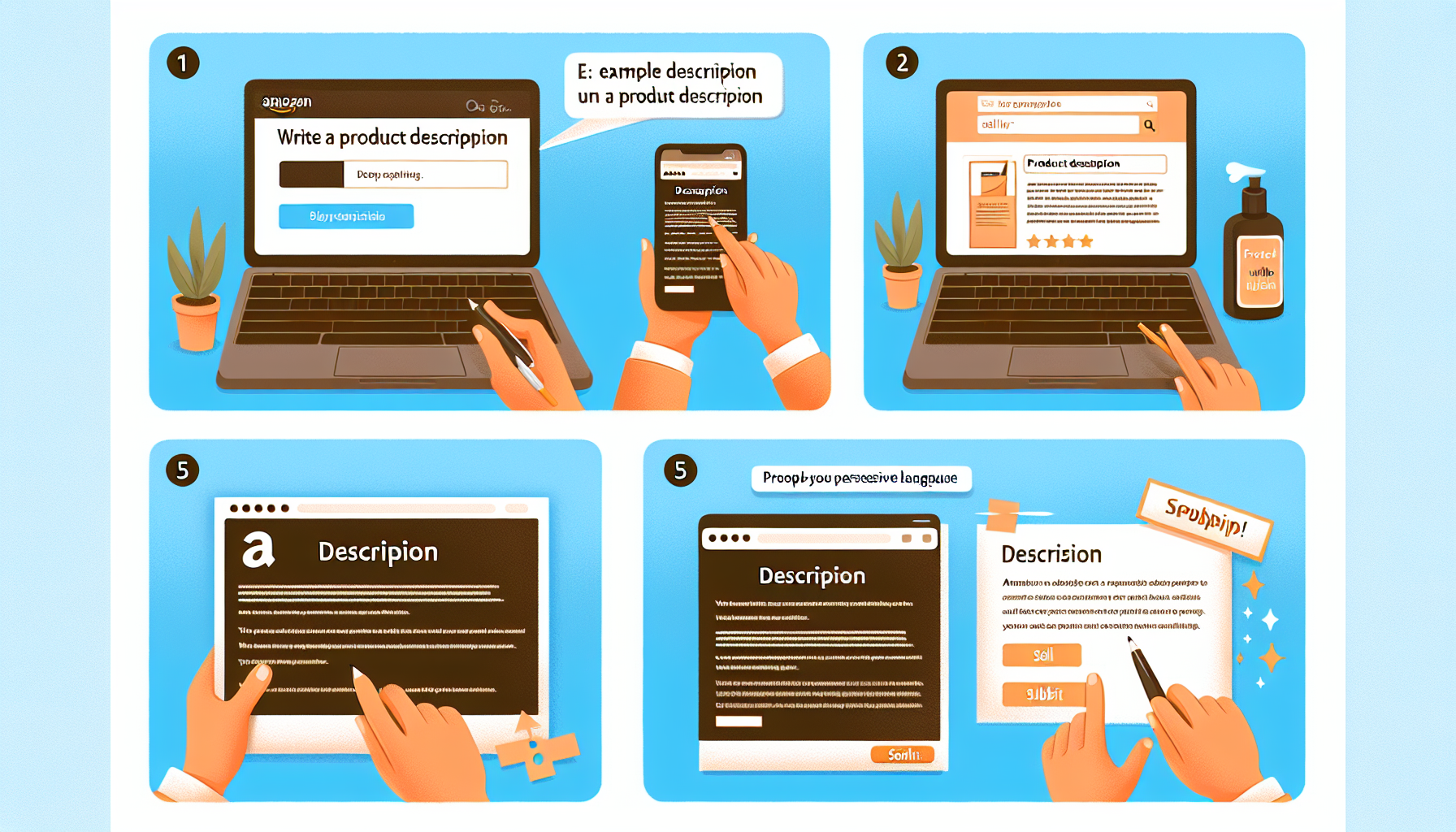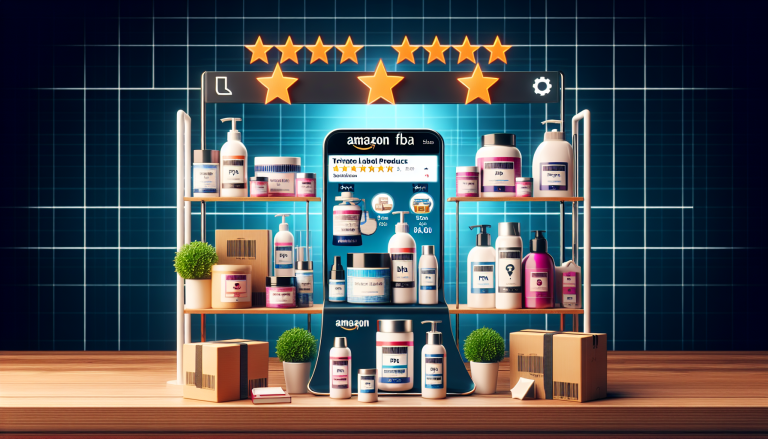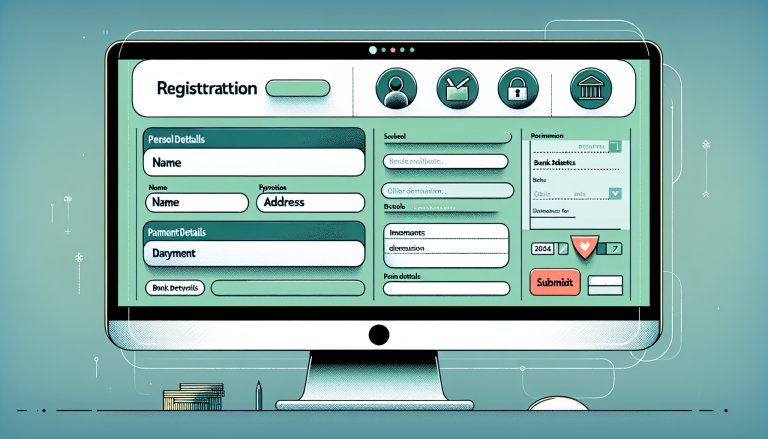Your product listing copy can make or break your business on Amazon. Think about it – small conversion-focused optimizations can lead to thousands or even hundreds of thousands of dollars in sales over the life of a product that would otherwise be lost. That’s why it’s important that your ads are well optimized, which will lead to better ranking in search results and therefore higher conversions. In this article, we will take an in-depth look at product descriptions, one of the key elements of a strong product listing. By the end of this article, you should have an understanding of how to write an effective product description, and just as importantly, how NOT to write one. But first, let’s take a look at what makes a great product description.
What makes an effective product description?
If one of the main goals of your Amazon listing, including the description, is to rank high in search results, you first need to consider how Amazon ranks products. Amazon uses a computer algorithm called A9 to determine where items rank in search results.
One of the main ways the A9 algorithm works is by examining the keywords used in your listing to understand what your product is about. Therefore, one of the most important components of a strong description is the inclusion of relevant keywords. The goal is to teach Amazon’s algorithm to understand your product. It’s equally important to exclude irrelevant keywords so that you don’t get indexed for the wrong queries, meaning you don’t want A9 telling you the wrong thing about your product. Given the importance of this issue, we’ll discuss ways to do keyword research in another post.
The second factor is your sales history. In other words, there is a very reliable correlation between the products that sell the most often and those that rank highest in search results. Why does Amazon put the highest-returning products at the top of the results? Simply because it makes them the most money. It’s also the best way to operate because it satisfies the most people. Think about it… By placing the top sellers higher in the results, Amazon makes the most money, the seller makes the most money, and the most customers are served that way.
So in addition to the right keywords, your descriptions should follow fundamental copywriting principles to maximize conversion. Conversion-oriented copy means more sales, which means the algorithm will rank us higher in search results, leading to more visibility, which in turn creates more sales. Thus, the result is a reverse cycle of upward growth. Before we get into the details of conversion-oriented copy, let’s start with the basics.
Why do people buy anything?
People buy simply because they expect some kind of return/benefit, whether it’s a solution to a pressing problem or simple pleasure. Think back to the last time you bought something. A toilet bowl plunger solves the painful (and unpleasant) problem of a clog. The cinnamon bun you bought at the mall when you weren’t even hungry was just for fun….. not necessarily to solve the problem.
To create compelling copy, we need to focus on both of these factors: the pain points that are being solved and the simple pleasure a customer can experience – these are the benefits that make people buy. To effectively communicate these benefits, we must first get into the mindset of our ideal buyer so that our article can speak to them. Let’s create a buyer persona that will help us do just that.
Step 1: Creating a buyer persona
A buyer persona is simply a semi-fictionalized portrait of your ideal customer. To create a buyer persona, think about a typical customer in your target market and answer the following questions:
- What is his/her background? (Think back to work, family).
- What are his/her demographic characteristics? (Gender, age, income, location)
- What are his/her identifying characteristics? (Behavior, communication preferences)
- What are his/her motivations? (Goals, emotions, problems)
Here are the common motives for most purchases
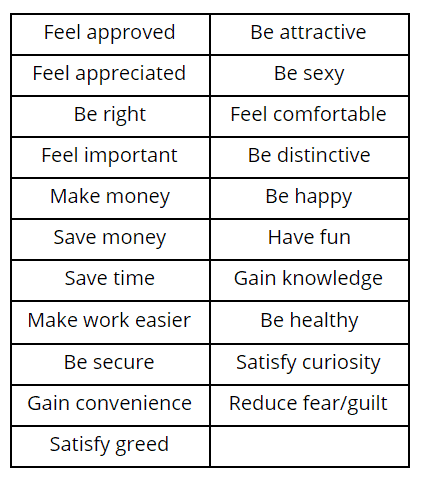
5. What are his/her pain points?
It will also help to give your semi-fictional character a name and even find a stock image to represent him/her.
Now that we know what a buyer persona is, let’s create one for a child’s behavior reward chart.
Name: Let’s name our imaginary buyer persona “Proactive Pearl”
What is her background? (Think about work, family).
Proactive Pearl is an experienced lawyer who just had her third child. Two is the perfect number and she has a vision for how she will live with three children. One key element of that vision is that she wants to instill healthy habits from an early age to set them up for success. After all, that’s what her parents pushed her to do, and now she appreciates it.
What are her demographics? (Gender, age, income, location)
Proactive Pearl is in her early thirties and earns a middle-class salary. She lives in a relatively affluent neighborhood, but certainly has no plans to settle there…. it’s just a stepping stone to her dream home – one of the major steps on her wish list.
What are their distinguishing characteristics? (Behavior, thought patterns).
Initiative Pearl is very future-oriented. She not only pursues her career goals, but also advances her personal goals. After all, her mantra is, “The prize is in progress.” There is no room in her life philosophy for the idea of “living for now” – perhaps later, when she has achieved all her goals. But for now, she is focused, keeping her eyes on her vision and taking daily steps to make those goals a reality.
What are her motivations? (Goals, Emotions, Challenges.)
She is driven by a balanced life of a successful career, socializing, fitness, and family. Her children are her life and everything she does, she does for them. She takes pride in being an active parent and investing in their future. She wants to provide them with everything they need, but at the same time teach them that you have to work hard to achieve what you want in life. Another motivating factor that drives her is a sense of accomplishment and having others around her recognize her accomplishments. Her biggest problem is focus. She wants to do so much that she doesn’t have enough time and energy to do everything, so she has a goal diary where she writes down only her priorities.
What are her pain points?
Her biggest fear is that her children won’t maximize the potential she knows they have. She fears that her children will acquire bad habits that will be hard to give up later, but she knows that if she helps them develop a few key behaviors, they will be successful in life and will be able to have successful careers and families. She knows that her career and life are very demanding in themselves, and is afraid that she will lose focus from the vision she has for them – she will feel guilty if that happens.
Step 2: Identify the benefits of your product
Once you have an idea of who you’re selling your product to and the reasons they might want to buy it, the next step is to connect the features and benefits of your product to their motivations. There’s an old marketing cliché that says, “People don’t buy features, they buy benefits.” And that’s really true. Think about the last time you bought a face mask, you weren’t thinking about the cotton material or the elastic strap, but the full coverage for your safety and comfort for your sanity.
To help uncover the benefits of our product, we’ll use a simple table of features and benefits. List all of your product’s features in one column, no matter how dry, boring or obvious they are, and in the other column, let’s think about why Proactive Pearl might need it, i.e. how each feature benefits her. You may want to revisit the list of buying motivations we discussed earlier. Pro tip: it helps to think of your product in terms of its most basic building blocks, e.g., a hexagonal pencil shaft means it won’t roll off the table; its 6″ length means a long writing life.
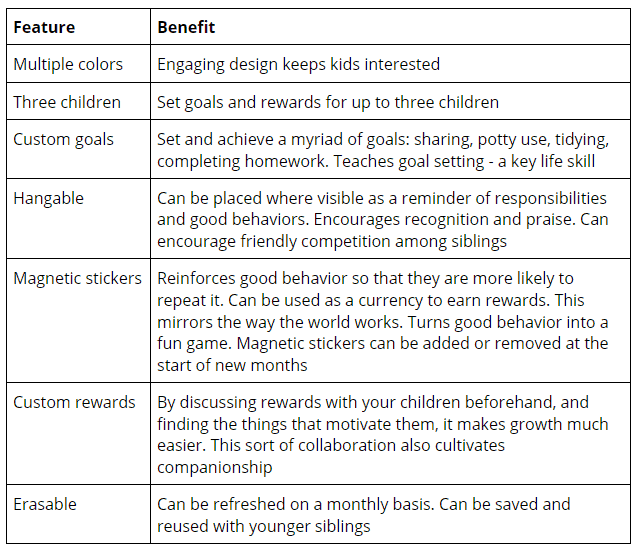
Step 3: Write a first draft
Now that we’ve done all the prep work, we can start writing. But where do we start? And what comes in the middle and at the end? Fortunately, there are proven copywriting formulas that answer exactly these questions. We like the AIDA formula:
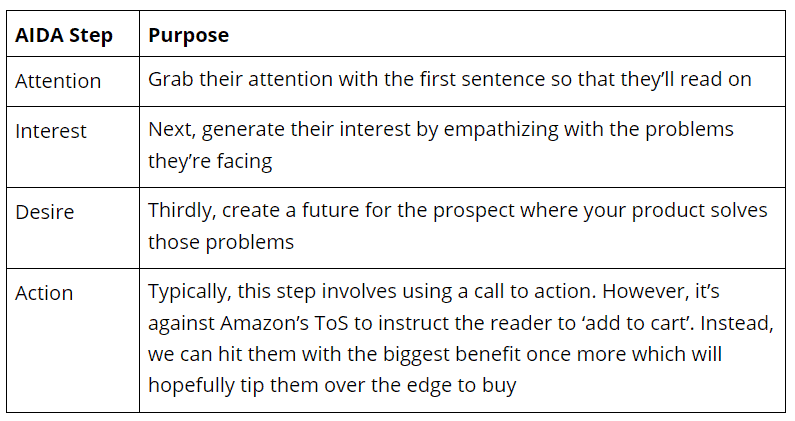
Here’s our description written using AIDA
Red – attention
Green – interest
Black – desire
Blue – call to action
This little-noticed strategy has been used by psychologists for the past 30 years to shape children’s behavior. If you want to stop certain behaviors, such as tantrums, or start others, such as cleaning, sharing time together, or even potty training, this strategy can help. What is this strategy, you ask? Reward Charts! The [Brand] Reward Chart is built on the same powerful psychological principles used by experts, and helps you effortlessly increase your children’s desirable behaviors and decrease undesirable ones.
With individualized goal and reward areas, you can set your own goals and use rewards that truly motivate your children. The stickers make it easy to recognize and reinforce good behavior and motivate children to repeat that behavior over and over again. The hanging design means you can place it almost anywhere to remind you and your child of desired goals and the rewards they will receive for successfully accomplishing them.The [Brand] chart also serves as a reminder of small successes on the way to a big result. Designed for up to 3 children, this table encourages friendly competition and cooperation, and makes goal achievement a fun game. Its multi-color design is engaging and perfect for children ages 5 to 10.
But isn’t this as manipulative, you ask, as training a dog? No! Our reward chart is a team effort that requires cooperation between parents and children. Not only does it foster a sense of camaraderie, but it also helps instill key goal-setting habits that will set your child up for future success. With magnetic stickers and an erasable surface, you can redesign the board at the beginning of each month or make adjustments as goals change. The board can even be saved and used with younger, future siblings, so you’ll be using it for years to come, and when they’re older, you can give it to a friend. So if you’re struggling with your kids’ behavior, go to [Brand], stop moaning and start growing together today!
Step 4: Edit your first draft using these pro tips:
Don’t sell hard
People like to buy, but no one likes to be sold to. Think back to the last time an insurance agent tried to sell you a policy. Once you realized the purpose of the conversation, you were probably wary. This well-documented phenomenon in psychology is called resistance to persuasion. We tend to resist being persuaded or sold against our initial inclination, probably because we assume it benefits them rather than us. Hence the conclusion: avoid overly salesy language. It’s likely that your customers already know what they need and are just trying to check the box in their minds – if your product fits their profile, they’ll buy. Don’t create unnecessary resistance.
Write for people, not search engines
One common mistake people make is over-optimizing an ad by stuffing it with keywords. This leads to text that is difficult to read as it tends to be poorly readable. If customers don’t want to read, they are less likely to make a purchase. So, oddly enough, this is a situation where less can mean more.
Instead of overloading your site, strive for balance. It’s helpful to think about the fact that you should write your texts for people and smoothly incorporate keywords for the A9 algorithm.
Keywords only need to be added once to be indexed. For example, if you sell silk hair bonnets, you don’t need to add the phrases “silk hair bonnets” and “silk hair bonnets for women” just because they are two phrases in high demand. Once silk hair bonnet is used in the text, it is worth your while to include the word “women” elsewhere and A9 will realize it.
Short Sells
Every line in your description should have a purpose. This is a very useful way to think about and analyze your entire ad. Think about it… The purpose of your headline is to get the client to click on your ad on the search engine results page and read the first line. The purpose of the first headline is to get the client to read the second and so on.
The same goes for your description. Each line should lead to another from start to finish with one goal – to get them to click the button, i.e. “Add to Cart”. Don’t expand your text just for the sake of running out of character limit – only add text if it will help the customer get to the button, and do it in as few words as possible. Remember that attention spans are short, and the more a shopper has to scroll and read, the more attention they draw to competitors’ products that are trying to steer them away from your ad.
Comply with Amazon’s terms of service
One of the worst things that can happen is to start growing your business and then have your listing removed. This can happen if you violate Amazon’s terms of service. There are some things you can’t include in your product description.
Avoid:
- Promotional wording such as “best-selling” or “free shipping”
- Mentions of competing brands
- Reviews or quotes
- Information about availability, such as scarcity selling tactics
- Information about the condition of the product
Use HTML to give the text room to breathe
Large walls of text can be discouraging. In addition to keeping descriptions as short as possible, another good practice is to use HTML to break up text. Amazon officially only supports line breaks (
), but when used properly, that’s all you need.
Example:
No HTML:
Waspinator is a natural alternative to harmful pesticides. Advantages: Natural, effective, safe for the environment
Conclusion:

FROM HTML:
Vaspinator is a natural alternative to harmful pesticides.
Benefits:
Natural
Effective
Safe for the environment
Output data
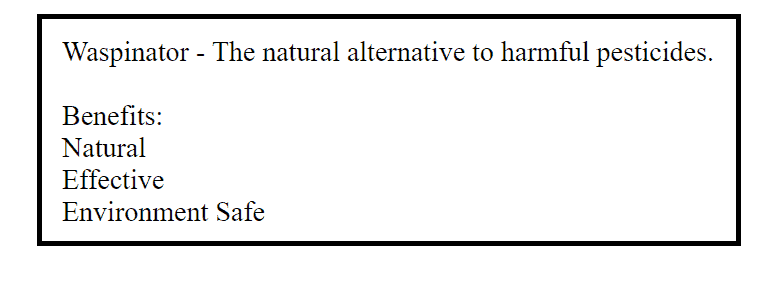
Notice how much more legible the HTML example reads. You can also get creative and add some quick bullet points to reinforce key selling points. To use line breaks, simply add
anywhere the text needs to move to the next line. Add twice
, if you want to skip a line. Some people use other HTML features like bolding. However, Amazon officially only allows line breaks. Given Amazon’s ever-changing policies and enforcement practices, we advise you to follow their ToS.
Negative reviews
In the description, like bullets, there is an opportunity to rebut common negative reviews. For example, let’s say you sell wasp nest lure (which scares away other people’s wasps because of their territorial nature), but it tends to lose color when exposed to the environment and customers complain about it and leave negative reviews – you can change your copy to set that expectation upfront. For example, in bullets or product descriptions, you could write, “The [Brand] Wasp’s Nest lure should not be directly exposed to the elements or it will lose its original color.” The idea is that buyers will have the right expectations upfront and will be less surprised if it does, reducing the likelihood of a negative review.
Use simple words
Amazon is used by people of different ages, education, and even language levels. A good rule of thumb for copywriting in general is to use simple, straightforward words instead of “big” words. Copywriting is not a genre where you need to wow the reader with your vocabulary. Here are some examples of substitutions, just to illustrate:
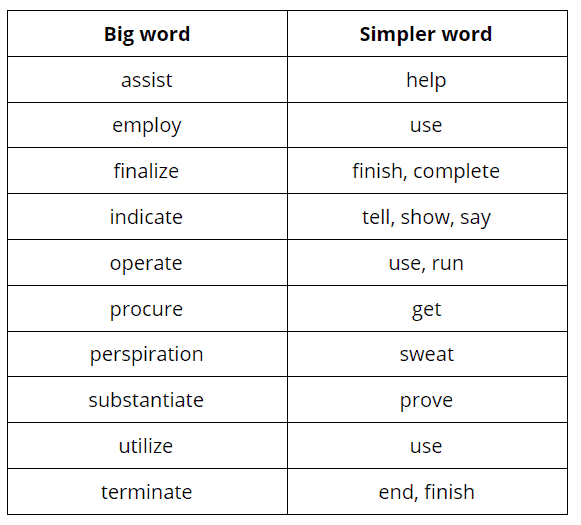
Avoid sexist language
Sexist language has the potential to offend, and when people are offended, it’s nearly impossible to sell to them. Instead, use gender-neutral terms or avoid them altogether. Here are some ideas for examples:
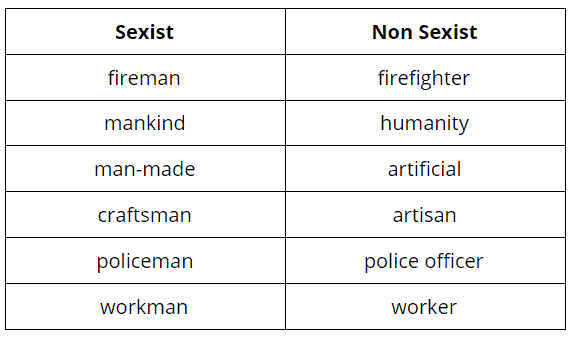
Use your brand voice
One of the keys to building a great business on Amazon is building your brand. In addition to adding your brand story to your listings, you can also write product descriptions using your brand voice. This way, your customers will have a consistent experience across all your products and all platforms. This investment in branding will help build loyalty and increase the chances of turning your shoppers into loyal customers.
A note about EBC
If you’ve registered a brand and are using Enhanced Brand Content for your products, you’ll notice that EBC suppresses the product description, meaning it doesn’t appear on the frontend for shoppers. The hypothetical indexing benefits of adding the description to the backend still exist. In addition, there are reports that Google’s web crawler can index keywords in the product description, which can help rank it in search results. What conclusion can be drawn? Add a description whether you use EBC or not.
Conclusion
If you’ve made it to this point, you now have a fully optimized product description that will allow you to rank higher in search results and convert more impressions into sales. To learn more ways to optimize and grow your Amazon business, check out our online training where you can get your first course for free.
